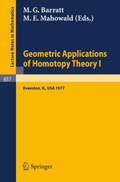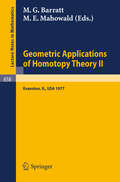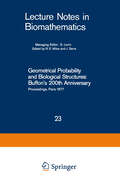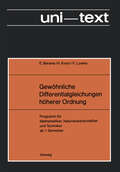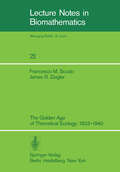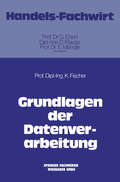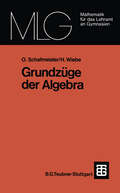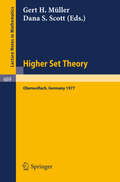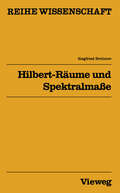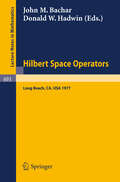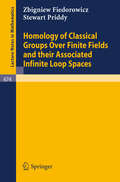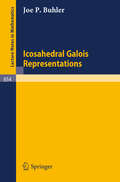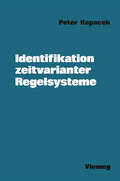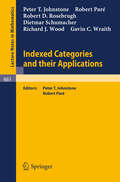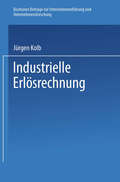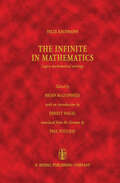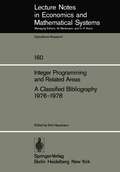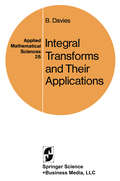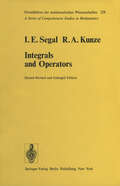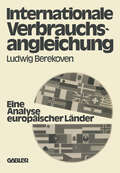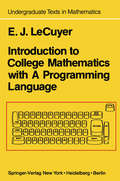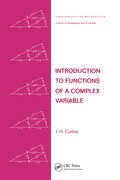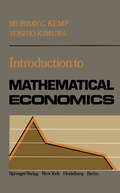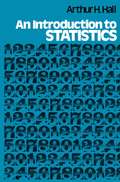- Table View
- List View
Geometric Applications of Homotopy Theory I: Proceedings, Evanston, March 21 - 26, 1977 (Lecture Notes in Mathematics #657)
by M. G. Barratt M. E. MahowaldGeometric Applications of Homotopy Theory II: Proceedings, Evanston, March 21 - 26, 1977 (Lecture Notes in Mathematics #658)
by M. G. Barratt M. E. MahowaldGeometrical Probability and Biological Structures: Proceedings of the Buffon Bicentenary Symposium on Geometrical Probability, Image Analysis, Mathematical Stereology, and Their Relevance to the Determination of Biological Structures, Held in Paris, June 1977 (Lecture Notes in Biomathematics #23)
by R. E. Miles J. SerraGewöhnliche Differentialgleichungen höherer Ordnung: - Übungsprogramm - Programm für Mathematiker, Naturwissenschaftler und Techniker ab 1. Semester
by Berane EdithThe Golden Age of Theoretical Ecology: 1923–1940 (Lecture Notes in Biomathematics #22)
by F.M. Scudo J.R. ZieglerThis is the part of any book where the authors usually discuss why they wrote it. We hope, however, that the text will justifY itself. In fact, any well-trained ecologist will immediately grasp the significance of these seminal works. We have therefore tried to keep our interpretive comments to a minimum. Students of "modern" theoretical ecology will want to contrast the papers in this collection with their modern derivatives. We believe that those who do so will be surprised, if not amazed, by the ecological sophistication and intellectual power of the earlier works. They will stand as a challenge to those who study them, and we hope, provide a standard for the quality of their work. By presenting this collection of works, most of them not easily available and/or for the first time in English, we hope to help them attain the high level of recognition they deserve. We are also enabling readers not sufficiently familiar with Italian to acquire enough of a background to properly follow the works in French not presented here by including Volterra's "Variazioni e fluttuazioni del numero d' indi vidui in specie animali convi venti" (1927), still available. in the original edition.
Grundzüge der Algebra (Mathematik für das Lehramt an Gymnasien)
by Otto Schafmeister Hartmut WiebeAlgebra ist neben Analysis und Geometrie eine der tragenden Säulen der Schulmathe matik und der Mathematik überhaupt. Wir haben in diesem Band versucht, eine Aus wahl aus der klassischen Algebra und der elementaren Zahlentheorie zu treffen, die als Hintergrundinformation ftir den Mathematiklehrer am Gymnasium sinnvoll erscheint. Bei der ersten Bekanntschaft mit Algebra stehen das Zahlenrechnen und die Suche nach Lösungen ftir einfache Gleichungen im Vordergrund. Wir geben daher nach einer kurzen Darstellung der wichtigsten algebraischen Grundbegriffe einen vollständigen überblick über den Aufbau des Zahlsystems, wobei es uns darauf ankam, die Zahl bereichserweiterungen als Spezialfall allgemeiner algebraischer Konstruktionen heraus zuarbeiten. So zeigen wir die Gemeinsamkeiten bei der Konstruktion der ganzen und der rationalen Zahlen auf und gewinnen die reellen Zahlen und die komplexen Zahlen durch die allgemeinen Prozesse der Vervollständigung angeordneter Körper bzw. der Adjunktion von Nullstellen. Bei den Ausftihrungen über Gruppen legen wir besonderes Gewicht auf Beispiele ftir endliche Gruppen: Permutationsgruppen, Gruppen kleiner Ordnung, endliche Bewe gungsgruppen der Ebene. Einen zentralen Platz nimmt die ausftihrliche Behandlung der Teilbarkeitslehre ein. Neben den Anwendungen bei ganzen Zahlen und Polynomen gehen wir exemplarisch auf die Zahlentheorie des Ringes der ganzen Gaußschen Zahlen ein und zeigen, wie sich zahlentheoretische Aussagen über diesen Ring in Aussagen über Quadratsummen natürlicher Zahlen übersetzen lassen.
Higher Set Theory: Proceedings, Oberwolfach, Germany, April 13-23, 1977 (Lecture Notes in Mathematics #669)
by G. H. Müller D. S. ScottHilbert Space Operators: Proceedings, California State University Long Beach, Long Beach, California, 20-24 June, 1977 (Lecture Notes in Mathematics #693)
by J. M. Bachar D. W. HadwinHomology of Classical Groups Over Finite Fields and Their Associated Infinite Loop Spaces (Lecture Notes in Mathematics #674)
by Z. Fiedorowicz S. PriddyIndexed Categories and Their Applications (Lecture Notes in Mathematics #661)
by P.I. Johnstone R. Pare R.D. Rosebrugh D. Schumacher R.J. Wood G.C. WraithIndustrielle Erlösrechnung — Grundlagen und Anwendung (Bochumer Beiträge zur Unternehmensführung und Unternehmensforschung #19)
by Jürgen KolbThe Infinite in Mathematics: Logico-mathematical writings (Vienna Circle Collection #9)
by Felix KaufmannThe main item in the present volume was published in 1930 under the title Das Unendliche in der Mathematik und seine Ausschaltung. It was at that time the fullest systematic account from the standpoint of Husserl's phenomenology of what is known as 'finitism' (also as 'intuitionism' and 'constructivism') in mathematics. Since then, important changes have been required in philosophies of mathematics, in part because of Kurt Godel's epoch-making paper of 1931 which established the essential in completeness of arithmetic. In the light of that finding, a number of the claims made in the book (and in the accompanying articles) are demon strably mistaken. Nevertheless, as a whole it retains much of its original interest and value. It presents the issues in the foundations of mathematics that were under debate when it was written (and in some cases still are); , and it offers one alternative to the currently dominant set-theoretical definitions of the cardinal numbers and other arithmetical concepts. While still a student at the University of Vienna, Felix Kaufmann was greatly impressed by the early philosophical writings (especially by the Logische Untersuchungen) of Edmund Husser!' He was never an uncritical disciple of Husserl, and he integrated into his mature philosophy ideas from a wide assortment of intellectual sources. But he thought of himself as a phenomenologist, and made frequent use in all his major publications of many of Husserl's logical and epistemological theses.
Integer Programming and Related Areas A Classified Bibliography 1976–1978: Compiled at the Institut für Ökonometrie und Operations Research, University of Bonn (Lecture Notes in Economics and Mathematical Systems #160)
by D. HausmannIntegral Transforms and Their Applications (Applied Mathematical Sciences #25)
by B. DaviesThis book is intended to serve as introductory and reference material for the application of integral transforms to a range of common mathematical problems. It has its im mediate origin in lecture notes prepared for senior level courses at the Australian National University, although I owe a great deal to my colleague Barry Ninham, a matter to which I refer below. In preparing the notes for publication as a book, I have added a considerable amount of material ad- tional to the lecture notes, with the intention of making the book more useful, particularly to the graduate student - volved in the solution of mathematical problems in the physi cal, chemical, engineering and related sciences. Any book is necessarily a statement of the author's viewpoint, and involves a number of compromises. My prime consideration has been to produce a work whose scope is selective rather than encyclopedic; consequently there are many facets of the subject which have been omitted--in not a few cases after a preliminary draft was written--because I v believe that their inclusion would make the book too long.
Integrals and Operators (Grundlehren der mathematischen Wissenschaften #228)
by I.E. Segal R.A. KunzeTO THE SECOND EDITION Since publication of the First Edition several excellent treatments of advanced topics in analysis have appeared. However, the concentration and penetration of these treatises naturally require much in the way of technical preliminaries and new terminology and notation. There consequently remains a need for an introduction to some of these topics which would mesh with the material of the First Edition. Such an introduction could serve to exemplify the material further, while using it to shorten and simplify its presentation. It seemed particularly important as well as practical to treat briefly but cogently some of the central parts of operator algebra and higher operator theory, as these are presently represented in book form only with a degree of specialization rather beyond the immediate needs or interests of many readers. Semigroup and perturbation theory provide connections with the theory of partial differential equations. C*-algebras are important in har monic analysis and the mathematical foundations of quantum mechanics. W*-algebras (or von Neumann rings) provide an approach to the theory of multiplicity of the spectrum and some simple but key elements of the gram mar of analysis, of use in group representation theory and elsewhere. The v vi Preface to the Second Edition theory of the trace for operators on Hilbert space is both important in itself and a natural extension of earlier integration-theoretic ideas.
Introduction to College Mathematics with A Programming Language (Undergraduate Texts in Mathematics)
by Edward J. LeCuyerThe topics covered in this text are those usually covered in a full year's course in finite mathematics or mathematics for liberal arts students. They correspond very closely to the topics I have taught at Western New England College to freshmen business and liberal arts students. They include set theory, logic, matrices and determinants, functions and graph ing, basic differential and integral calculus, probability and statistics, and trigonometry. Because this is an introductory text, none of these topics is dealt with in great depth. The idea is to introduce the student to some of the basic concepts in mathematics along with some of their applications. I believe that this text is self-contained and can be used successfully by any college student who has completed at least two years of high school mathematics including one year of algebra. In addition, no previous knowledge of any programming language is necessary. The distinguishing feature of this text is that the student is given the opportunity to learn the mathematical concepts via A Programming Lan guage (APL). APL was developed by Kenneth E. Iverson while he was at Harvard University and was presented in a book by Dr. Iverson entitled A i Programming Language in 1962. He invented APL for educational purpo ses. That is, APL was designed to be a consistent, unambiguous, and powerful notation for communicating mathematical ideas. In 1966, APL became available on a time-sharing system at IBM.
Introduction to Functions of a Complex Variable
by J. H. CurtissThis book includes information on elementary general topology, the Cauchy Integral Theorem and concepts of homology and homotopy in their application to the Cauchy theory. It is intended for an introductory course in complex analysis at the first-year graduate and advanced undergraduate level.
Introduction to Functions of a Complex Variable
by J. H. CurtissThis book includes information on elementary general topology, the Cauchy Integral Theorem and concepts of homology and homotopy in their application to the Cauchy theory. It is intended for an introductory course in complex analysis at the first-year graduate and advanced undergraduate level.
Introduction to Mathematical Economics
by M.C. Kemp Y. KimuraOur objectives may be briefly stated. They are two. First, we have sought to provide a compact and digestible exposition of some sub-branches of mathematics which are of interest to economists but which are underplayed in mathematical texts and dispersed in the journal literature. Second, we have sought to demonstrate the usefulness of the mathematics by providing a systematic account of modern neoclassical economics, that is, of those parts of economics from which jointness in production has been excluded. The book is introductory not in the sense that it can be read by any high-school graduate but in the sense that it provides some of the mathematics needed to appreciate modern general-equilibrium economic theory. It is aimed primarily at first-year graduate students and final-year honors students in economics who have studied mathematics at the university level for two years and who, in particular, have mastered a full-year course in analysis and calculus. The book is the outcome of a long correspondence punctuated by periodic visits by Kimura to the University of New South Wales. Without those visits we would never have finished. They were made possible by generous grants from the Leverhulme Foundation, Nagoya City University, and the University of New South Wales. Equally indispensible were the expert advice and generous encouragement of our friends Martin Beckmann, Takashi Negishi, Ryuzo Sato, and Yasuo Uekawa.
